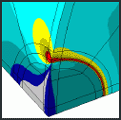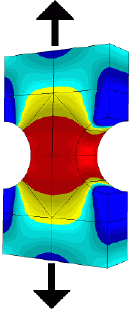The Challenge - Accurate and reliable stresses and Stress Intensity Factors are required for determination of static and residual strength and for crack growth analyses in analysis tools such as AFGROW. For some geometries, industry solutions are either insufficient or nonexistent. The geometry, applied forces, and crack shapes and dimensions must be modeled reasonably well to obtain useful engineering data. The p-version finite element software StressCheck (ESRD, Inc., St. Louis, Missouri, USA) is used to demonstrate how accurate finite element solutions can lead to good quality engineering analysis.

Engineered Solution - Fracture mechanics methods are applied to cracking and fatigue analysis in a typical round bar test coupon. Typically, thumbnail cracks will nucleate at the surface of the narrowest, gage section of the round bar. The peak fatigue load is applied away from the tapered gage section, and a crack is modeled at the anticipated nucleation location. The reliability of the finite element solutions are evaluated by determining the smoothness of stress contours and by evaluating convergence of the data of interest, the Stress Intensity Factors. A close-up of the equivalent stress contours (von Mises) near the thumbnail crack is shown. Stress Intensity Factors along the crack front are used in AFGROW to assess specimen fatigue life to failure. Fatigue marker bands applied during the test are used to determine the evolution of crack sizes and aspect ratios, and crack shapes are correlated with the analytical stress intensity variations along the crack front.

Static strength in an aluminum test coupon that is loaded with far field tension stress is evaluated with a full 3D finite element model. The applied tension stress is large enough to possibly induce plasticity in the test coupon in high stress regions, therefore the material was modeled as a nonlinear, Ramberg-Osgood elastoplastic one. The calculated von Mises stress field on the surface of the coupon is shown at the left. Strain gage measurements taken during the test correlated very well with finite element calculated stress and strain fields; results were published in an engineering journal paper authored by B. Connolly and J. Scully in the journal Corrosion/2000.

 home
home